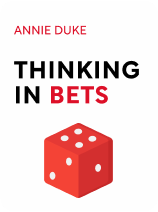

This article is an excerpt from the Shortform book guide to "Thinking in Bets" by Annie Duke. Shortform has the world's best summaries and analyses of books you should be reading.
Like this article? Sign up for a free trial here .
What constitutes biased decision-making? Are you guilty of it?
We all tend to let our biases influence our decisions. While we can’t completely eliminate distorted beliefs, we can get better at managing bias—and keep biased decision-making at bay.
Read more to learn how to recognize and mitigate biased decision-making.
The Root of Biased Decision-Making
Our beliefs can even affect how we perceive shared experiences. That effect can happen on a small scale—how many times have you viewed another person’s innocuous comments or actions in a negative light simply because you already dislike them based on an unrelated, past experience?
But your beliefs can also influence how you process objective facts on a larger scale, as a pair of psychology professors from Dartmouth and Princeton observed in a study of how students from each of their schools viewed a football game between their teams. Because of the deeply entrenched rivalry between them, emotions ran high, and sharply different narratives emerged from each set of students (as well as the school newspapers that covered the game). Students noticed and remembered more penalties committed by the opposite team, and fewer committed by their own. They projected aggression and pinned blame on the opposition, and downplayed the infractions committed by the team they supported. They’d all watched the same game, but they came away with conflicting narratives about what had happened.
And that’s just college football. Consider the ways that this belief-based processing of what should be objective information affects how we view things such as news events and politics.
When old beliefs color our perception of new information, that feeds back into our existing biases and intensifies them. This cycle is called “motivated reasoning.” That’s why the phenomenon known as fake news is so insidious—and so effective. It’s not converting anyone to a brand new way of thinking—it’s designed to reinforce existing beliefs. If those beliefs were suppressed or buried, that extra fuel can bring them to the surface. And the algorithms in our social media feeds and search engines, designed to cater to our existing preferences, ensure that we’re fed a stream of information that reinforces the way we already think and feel rather than challenging it.
Similarly, every few years, news articles claiming there’s no scientific proof that flossing is necessary go viral. Many people are eager to share and believe these articles without researching beyond the headlines. Why? Because they just don’t like flossing. They’re biased in favor of anything that makes them feel less guilty about not flossing often enough. Dentists do continue to recommend flossing daily, and the claims that “science” doesn’t support a need to floss have many caveats attached. But the articles still get written and shared, not because they’re revelatory, but because they reinforce existing feelings and beliefs.
With our own natures and the very technology that’s supposed to make our lives easier working against us in this way, we have to make a conscious choice to check ourselves and the beliefs that we’re internalizing. If we don’t, we engage in biased decision-making.
(Shortform note: For more on how bias can impact your life, read our guide to Biased.)
Hindsight Bias in Decision-Making
Avoid falling into the trap of “hindsight bias”—which is how, once we’ve learned the outcome of a decision, we’re prone to thinking it was obvious and we should’ve predicted it beforehand. It only seems obvious because, as the saying goes, “hindsight is 20/20.” But in the moment, things are never that simple.
(Shortform note: To learn more about how to avoid hindsight bias, read our guide to Thinking, Fast and Slow.)
Self-Serving Bias in Decision-Making
We’re prone to “self-serving bias”—we own the positive outcomes, attributing them to skill, and brush off the negative ones as bad luck. We don’t want bad things to be our fault. It’s tempting to give in to self-serving bias even if we’ve accepted that most outcomes result from a combination of luck and skill.
Tips for Managing Bias
Scenario planning can protect you from hindsight bias. If you’ve considered all the different outcomes, the one that actually happens won’t seem like it was inevitable—especially if the outcome that happens is one that you’d guessed had a low probability of occurring. That awareness will make you a more accurate judge of your own decisions, able to have compassion for yourself and others when things go wrong, able to keep from becoming overconfident about a success, and ready to make similar decisions going forward.
To manage self-serving bias, engage in self-reflection, view situations from multiple perspectives, and find alternative ways to uplift your self-perception so you’re not relying on bias for this boost.
For managing bias of any kind, rely on a group to hold you accountable. A good group cares about accuracy. Members will call out each other’s biases and engage in civil disagreement.
Being a good decision-maker means staying rational in the face of losses. You won’t always be right, but you can always be working toward objectivity and away from emotional or biased decision-making.

———End of Preview———
Like what you just read? Read the rest of the world's best book summary and analysis of Annie Duke's "Thinking in Bets" at Shortform .
Here's what you'll find in our full Thinking in Bets summary :
- How to get better at making good decisions
- How to work around your biases
- How to evaluate and learn from your past






